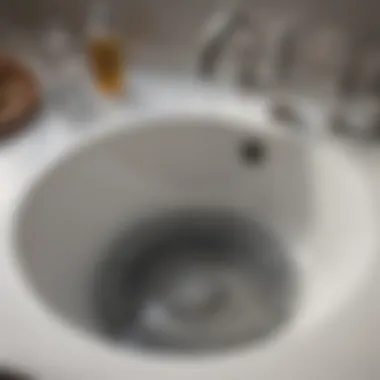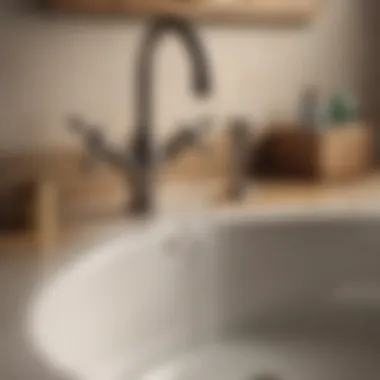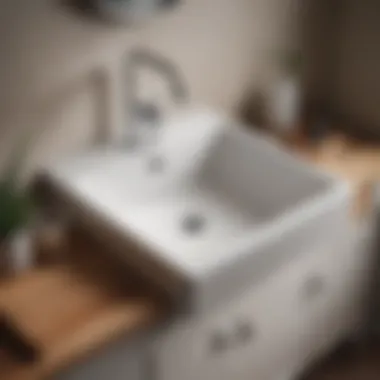A Comprehensive Guide to Clearing a Clogged Sink Trap for Effective Maintenance


Inspiring Homes
When it comes to maintaining a functional and clean sink, understanding how to clear a clogged sink trap is essential. Sink traps play a crucial role in preventing clogs and ensuring proper drainage in your sink. By learning the step-by-step process of clearing a clogged sink trap, you can avoid potential plumbing issues and keep your sink running smoothly. Whether you're a homeowner looking to tackle DIY projects or someone curious about plumbing maintenance, this guide will equip you with the knowledge needed to effectively troubleshoot and resolve common sink problems.
Sink traps, also known as P-traps, are U-shaped pipes located beneath the sink that trap debris and prevent it from clogging the main drainage system. Over time, substances like grease, soap scum, and food particles can accumulate in the trap, leading to slow drainage or complete blockages. By regularly cleaning the sink trap, you can prevent clogs and maintain optimal sink functionality. In this comprehensive guide, we will walk you through the importance of sink traps and provide a detailed overview of how to clear a clogged sink trap efficiently.
To start the process of clearing a clogged sink trap, gather the necessary tools and materials, including a bucket, adjustable wrench, old towels or rags, and a drain snake or wire coat hanger. It's important to wear protective gloves to avoid direct contact with debris and potentially harmful substances. Before proceeding, ensure you have turned off the water supply to the sink to prevent any leakage or spills during the cleaning process.
Once you have assembled your tools and materials, place the bucket beneath the sink trap to catch any water or debris that may spill out during the removal process. Using an adjustable wrench, carefully loosen the slip nuts on either side of the trap to detach it from the sink's drain pipes. Be prepared for some water and debris to drain out once the trap is removed. Inspect the trap for any visible clogs or obstructions and clear them using a drain snake or wire coat hanger.
With the clog removed, clean the sink trap thoroughly with warm, soapy water to remove any remaining residue or buildup. You can also use a mild household cleaner or vinegar solution to disinfect the trap and eliminate any odors. Once the trap is clean, reattach it to the drain pipes and tighten the slip nuts securely with your wrench. Turn on the water supply and run water through the sink to test for proper drainage and check for any leaks.
Introduction
Sink traps play a vital role in maintaining proper drainage in our sinks, ensuring wastewater flows smoothly without causing any obstructions or unpleasant odors. Understanding the significance of sink traps is essential for every homeowner and DIY enthusiast. This guide will delve into the key aspects of sink traps, from their function to the importance of regular maintenance to prevent clogs and maintain optimal plumbing performance.
Understanding Sink Traps
What is a sink trap?
A sink trap, also known as a P-trap, is a crucial plumbing component designed to trap debris, preventing it from clogging the drain further down the pipe. The unique U-shape of a sink trap retains a small amount of water, creating a barrier that prevents foul odors from backing up into the sink. This ingenious design not only enhances drainage efficiency but also helps maintain a hygienic environment in your kitchen or bathroom.
Importance of sink traps in plumbing


Sink traps are indispensable in plumbing systems as they serve as a barrier against sewer gases and odors, protecting your living space from unsanitary conditions. Their simple yet effective design not only prevents clogs but also allows for easy access when cleaning or removing blockages. By understanding the importance of sink traps, homeowners can proactively maintain their plumbing systems, ensuring smooth wastewater flow and odor-free environments.
Signs of a Clogged Sink Trap
Slow drainage
Slow drainage is a clear indication of a clogged sink trap, signifying that debris or buildup is obstructing the water flow. This issue can lead to stagnant water, foul odors, and potential backups if left unaddressed. By recognizing the signs of slow drainage, homeowners can take prompt action to prevent further damage to the plumbing system and maintain optimal functionality.
Foul odors
Foul odors emanating from the sink are a common symptom of a clogged trap, indicating that stagnant water and debris have accumulated within the pipe. These odors not only pose a discomfort but also signal a potential health hazard due to bacterial growth. Addressing foul odors promptly by clearing the sink trap is essential to ensure a clean and hygienic environment in your home.
Tools and Materials Needed
Bucket
A bucket is an essential tool for catching water and debris when disassembling the sink trap. Its sturdy construction and large capacity make it ideal for containing wastewater and allowing for easy disposal. When clearing a clogged sink trap, having a bucket on hand is crucial for maintaining a clean work area and preventing water damage to surrounding surfaces.
Adjustable wrench
An adjustable wrench is indispensable for loosening and tightening the connections on the sink trap. Its versatile design allows for easy adjustment to fit various sizes of nuts and bolts, making it a convenient tool for DIY plumbing repairs. With an adjustable wrench, homeowners can efficiently remove the trap for cleaning and reassemble it without hassle.
Plumber's snake
A plumber's snake, also known as a drain auger, is a flexible tool designed to clear obstructions from pipes and drains. Its long, coiled design allows it to navigate through twists and turns in the plumbing system, breaking up clogs and debris effectively. With a plumber's snake, homeowners can tackle stubborn blockages in the sink trap and restore optimal water flow without resorting to harsh chemicals.


Steps to Clear a Clogged Sink Trap
Clearing a clogged sink trap is a crucial aspect of plumbing maintenance that ensures proper water drainage and prevents foul odors in your sink area. By following the steps outlined in this guide, you can effectively address any blockages in the sink trap, promoting a functional and clean plumbing system. The process may seem daunting at first, but with the right tools and know-how, you can successfully clear a clogged sink trap with ease.
Step 1: Prepare the Area
Gather necessary tools:
When preparing to clear a clogged sink trap, having the right tools at hand is vital for a successful outcome. Tools such as a bucket, an adjustable wrench, and a plumber's snake are essential for disassembling and cleaning the trap effectively. The bucket serves as a containment device for any water or debris that may flow out during the process, ensuring a tidy workspace and easy cleanup post-repair.
Place a bucket beneath the sink:
Positioning a bucket beneath the sink where the trap is located is a strategic move to catch any water or debris that may spill out during the disassembly process. This not only helps in maintaining cleanliness in the surrounding area but also prevents potential water damage to the flooring. Placing a bucket ensures that the workspace remains organized and facilitates a smoother operation.
Step 2: Loosen the Trap
Use an adjustable wrench:
An adjustable wrench is a versatile tool that allows you to loosen the connections holding the sink trap in place. Its adjustability makes it suitable for various nut sizes, providing a firm grip for effective loosening. This tool is essential for dismantling the trap without causing damage to the fittings, enabling a seamless disassembly process.
Carefully remove the trap:
After loosening the connections with the wrench, it's essential to carefully remove the trap from its position. Handling the trap with care prevents accidental spills and breakage, maintaining the integrity of the components for reassembly later. Gently extracting the trap ensures a smooth transition to the cleaning process.


Step 3: Clean the Trap
Inspect for debris:
One crucial step in clearing a clogged sink trap is inspecting it for any accumulated debris or blockages. Identifying and removing debris such as hair, food particles, or soap scum is key to restoring proper water flow in the plumbing system. Thorough inspection helps in targeting the specific areas that require cleaning, ensuring a comprehensive clearing process.
Use a plumber's snake to clear obstructions:
A plumber's snake is a flexible tool designed to navigate through pipes and dislodge stubborn clogs within the sink trap. Its ability to reach deep into the plumbing system allows for effective obstruction removal, restoring optimal water flow. Utilizing a plumber's snake assists in addressing blockages that are beyond the reach of conventional cleaning methods.
Step 4: Reassemble the Trap
Tighten connections:
Once the trap has been cleaned and the obstructions cleared, it's important to securely tighten the connections to prevent leaks and ensure proper functionality. Properly fastening the fittings with the adjustable wrench maintains the integrity of the trap, preventing future issues with water drainage. Tight connections guarantee a leak-free plumbing system.
Check for leaks:
After reassembling the trap, conducting a leak test is imperative to verify the integrity of the connections. Checking for leaks ensures that the trap is securely in place and that water flows smoothly without seepage. This final step in the process confirms the successful clearing of the sink trap and paves the way for a well-maintained plumbing fixture.
Preventive Maintenance Tips
Preventive maintenance tips play a crucial role in ensuring the long-term functionality and cleanliness of your sink traps. By incorporating regular maintenance practices, you can prevent clogs and unpleasant odors, ultimately saving time and money on potential repairs. One of the key elements to consider when implementing preventive maintenance tips is the use of enzyme-based cleaners. These specialized cleaners are designed to break down organic matter that builds up in sink traps, preventing clogs and promoting optimal drainage. Enzyme-based cleaners are popular choices for maintaining sink traps due to their effectiveness in eliminating grease, food particles, and other residue that contribute to blockages. A unique feature of enzyme-based cleaners is their ability to target and digest organic materials, leaving behind a clean and odor-free system. While enzyme-based cleaners offer numerous advantages in maintaining sink traps, it is essential to note that some products may take longer to show results compared to conventional cleaners.
Another preventive maintenance tip is to flush the sink trap with hot water regularly. Hot water helps to dissolve grease and soap scum that may accumulate in the trap, preventing the formation of clogs. By flushing the trap with hot water after each use, you can dislodge debris and keep the pipes clear. The key characteristic of flushing with hot water is its ability to melt away greasy substances, ensuring smooth water flow and preventing foul odors. This simple yet effective method is a popular choice among homeowners for its convenience and cost-efficiency. A unique feature of flushing with hot water is its ability to sanitize and deodorize the sink trap, providing a hygienic environment for everyday use. However, it is important to exercise caution with extremely hot water to avoid damaging the pipes or causing injury.
Avoiding Clogs
To maintain clear and functional sink traps, it is crucial to implement strategies that help avoid clogs. One specific aspect to consider is avoiding dumping grease down the drain. Grease solidifies when it cools, creating obstructions in the pipes and trap. By disposing of grease properly in a separate container instead of pouring it down the drain, you can prevent blockages and extend the lifespan of your plumbing system. The key characteristic of avoiding dumping grease is its impact on reducing blockages and preventing foul smells in the sink. This approach is a beneficial choice for maintaining the efficiency of sink traps and preventing costly repairs. A unique feature of avoiding dumping grease is its positive environmental impact, as it minimizes the accumulation of harmful substances in the sewage system.
Installing a hair catcher is another effective measure to avoid clogs in sink traps. Hair is a common culprit for blockages in drains, leading to slow drainage and potential backups. A hair catcher acts as a physical barrier, trapping hair and other debris before they enter the pipes and cause clogs. The key characteristic of installing a hair catcher is its ability to capture hair and prevent it from accumulating in the trap, reducing the risk of blockages. This simple yet practical solution is a popular choice for homeowners looking to maintain clean and efficient sink traps. A unique feature of installing a hair catcher is its ease of use and maintenance, making it a convenient addition to any sink. Although hair catchers offer significant benefits in preventing clogs, it is important to clean them regularly to ensure optimal performance.



